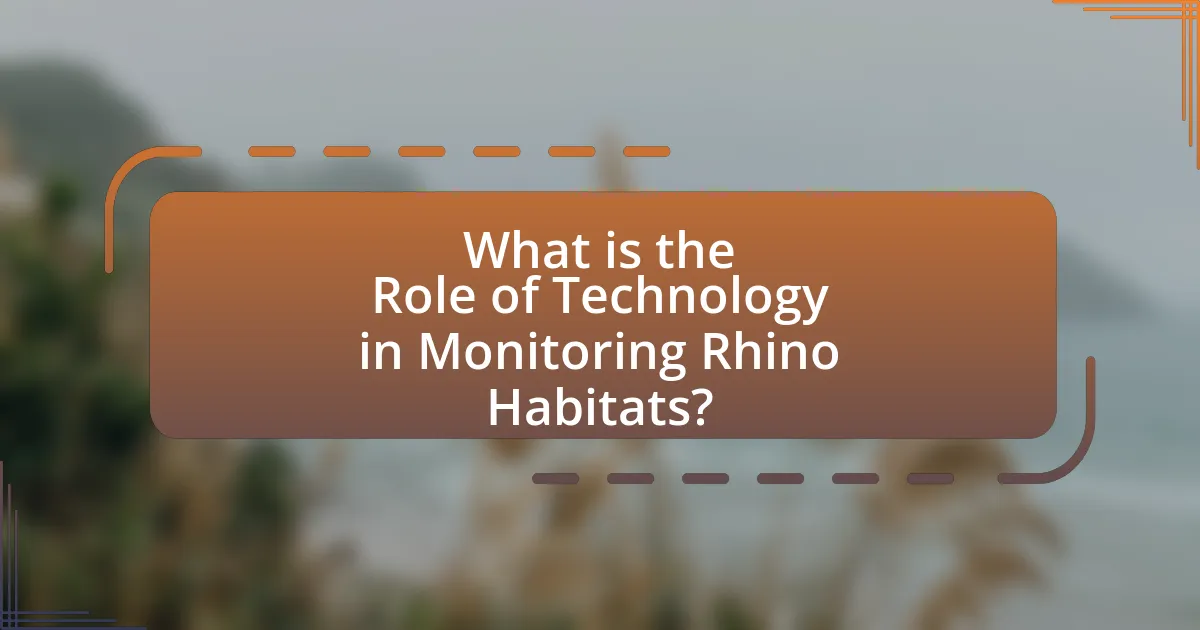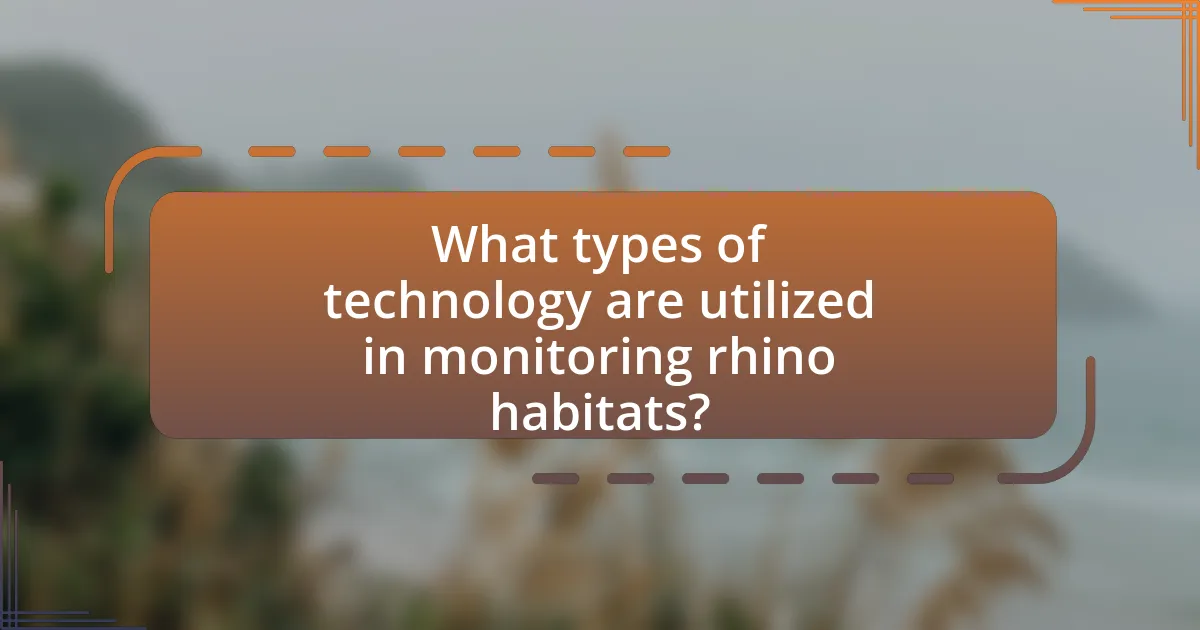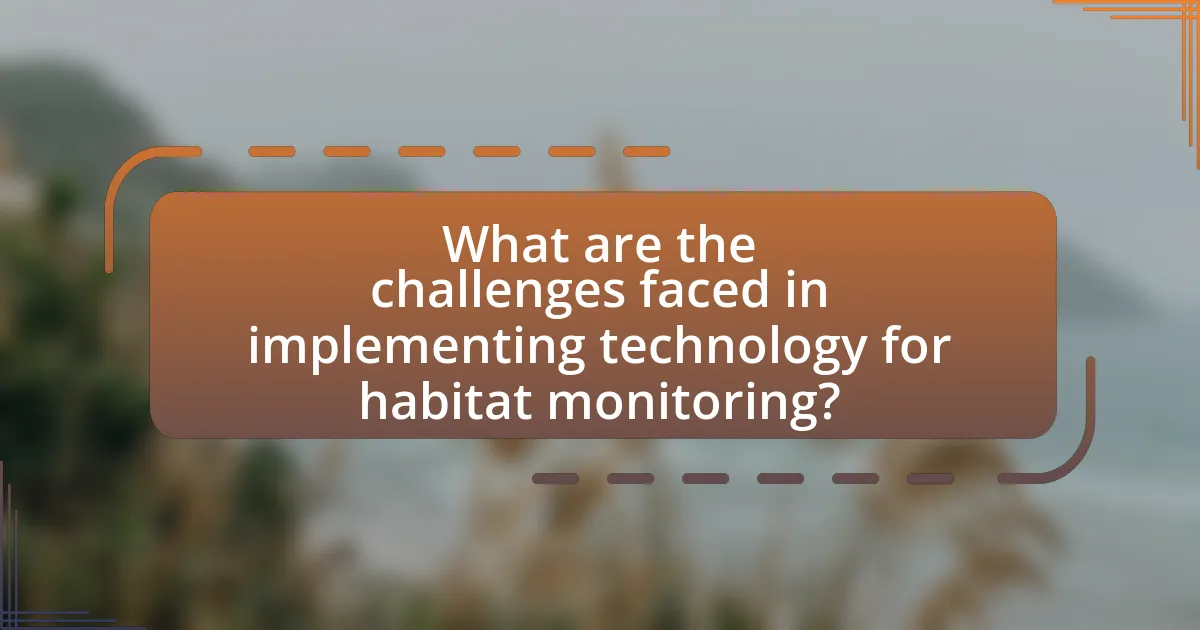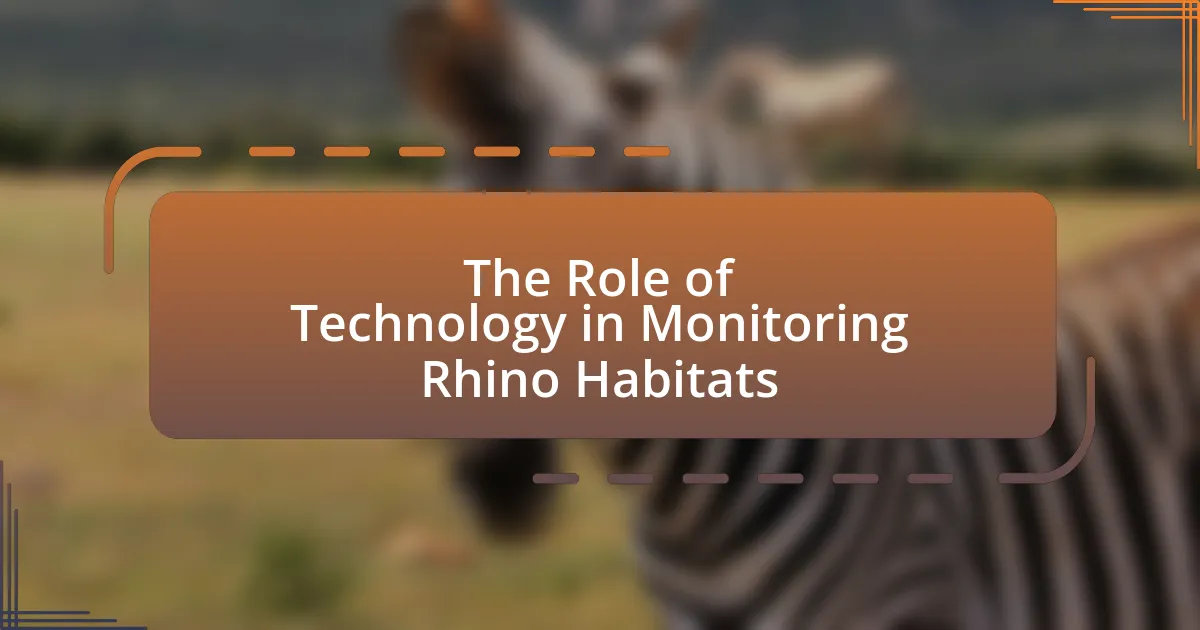The article focuses on the critical role of technology in monitoring rhino habitats, highlighting advancements such as GPS tracking, remote sensing, and automated camera traps. These technologies facilitate real-time data collection and analysis, enabling researchers to track rhino movements, assess habitat conditions, and enhance conservation strategies. Key challenges, including financial constraints and environmental factors, are discussed alongside the importance of community involvement and collaboration in effective monitoring efforts. The article emphasizes that integrating these technological tools is essential for addressing threats to rhino habitats and ensuring the sustainability of rhino populations.

What is the Role of Technology in Monitoring Rhino Habitats?
Technology plays a crucial role in monitoring rhino habitats by providing tools for data collection, analysis, and real-time tracking. Advanced technologies such as GPS collars enable researchers to track rhino movements and behaviors, while drones and satellite imagery allow for the assessment of habitat conditions and changes over time. For instance, a study published in the journal “Ecological Applications” highlights how remote sensing technology can identify habitat degradation and inform conservation strategies. Additionally, camera traps equipped with motion sensors capture images of rhinos and other wildlife, facilitating population monitoring and anti-poaching efforts. These technological advancements enhance the effectiveness of conservation initiatives and contribute to the protection of rhino habitats.
How has technology evolved in the context of wildlife monitoring?
Technology has evolved significantly in wildlife monitoring through advancements in remote sensing, GPS tracking, and data analytics. Remote sensing technologies, such as satellite imagery and drones, allow researchers to gather extensive data on animal habitats and movements without disturbing wildlife. GPS tracking devices have become smaller and more efficient, enabling real-time monitoring of animal behavior and migration patterns, which is crucial for species like rhinos. Additionally, data analytics tools have improved the ability to process and interpret large datasets, facilitating better decision-making for conservation efforts. For instance, studies have shown that the integration of these technologies has led to a 30% increase in the effectiveness of anti-poaching strategies in regions where rhinos are monitored.
What are the key technological advancements used in habitat monitoring?
Key technological advancements used in habitat monitoring include remote sensing, GPS tracking, and automated camera traps. Remote sensing utilizes satellite imagery and aerial drones to collect data on habitat changes and vegetation cover, enabling large-scale monitoring. GPS tracking allows researchers to follow the movements of rhinos in real-time, providing insights into their behavior and habitat use. Automated camera traps capture images of wildlife, helping to assess species presence and population dynamics. These technologies collectively enhance the accuracy and efficiency of habitat monitoring efforts, as evidenced by studies showing improved data collection and analysis in conservation projects.
How do these advancements improve data collection and analysis?
Advancements in technology significantly enhance data collection and analysis by enabling real-time monitoring and more accurate data gathering. For instance, the use of drones equipped with high-resolution cameras allows researchers to capture detailed images of rhino habitats, facilitating the assessment of vegetation and terrain changes. Additionally, GPS tracking devices provide precise location data, which helps in understanding rhino movement patterns and habitat utilization. These technologies lead to improved data accuracy and efficiency, as evidenced by studies showing that drone surveys can cover large areas in a fraction of the time compared to traditional methods, thus allowing for more frequent data collection and timely analysis.
Why is monitoring rhino habitats crucial for conservation efforts?
Monitoring rhino habitats is crucial for conservation efforts because it enables the identification of threats and the assessment of ecosystem health. By tracking changes in habitat conditions, conservationists can detect issues such as poaching, habitat loss, and climate change impacts. For instance, studies have shown that habitat degradation can lead to a decline in rhino populations, making it essential to monitor these environments to implement timely protective measures. Effective habitat monitoring can also inform management strategies, ensuring that resources are allocated efficiently to areas most in need of intervention.
What are the primary threats to rhino habitats that necessitate monitoring?
The primary threats to rhino habitats that necessitate monitoring include habitat loss, poaching, and climate change. Habitat loss occurs due to agricultural expansion, urban development, and deforestation, which reduces the available space for rhinos to live and thrive. Poaching, driven by the illegal demand for rhino horns, poses a direct threat to rhino populations and their habitats, as it often leads to increased human activity in these areas. Climate change further exacerbates habitat degradation by altering ecosystems and affecting food and water availability for rhinos. These threats highlight the urgent need for monitoring to ensure the conservation of rhino habitats and the species themselves.
How does habitat monitoring contribute to rhino population sustainability?
Habitat monitoring significantly contributes to rhino population sustainability by providing critical data on environmental conditions and threats. This data enables conservationists to assess habitat quality, identify changes due to climate or human activity, and implement targeted management strategies. For instance, studies have shown that effective habitat monitoring can lead to improved food availability and reduced poaching risks, directly supporting rhino populations. Additionally, technologies such as satellite imagery and GPS tracking enhance the ability to monitor vast areas, ensuring timely interventions that can prevent population declines.

What types of technology are utilized in monitoring rhino habitats?
Various technologies are utilized in monitoring rhino habitats, including satellite imagery, GPS tracking, drones, and camera traps. Satellite imagery allows for large-scale habitat assessment and changes over time, while GPS tracking provides real-time location data on rhinos, enabling researchers to study their movement patterns. Drones are employed for aerial surveys, offering a cost-effective method to monitor vast areas and detect poaching activities. Camera traps capture images of wildlife, helping to assess population dynamics and habitat use. These technologies collectively enhance conservation efforts by providing critical data for effective management and protection of rhino habitats.
What role do drones play in habitat monitoring?
Drones play a crucial role in habitat monitoring by providing high-resolution aerial imagery and data collection capabilities. These unmanned aerial vehicles enable researchers to assess vegetation health, track wildlife populations, and monitor changes in land use over time. For instance, studies have shown that drones can cover large areas quickly, capturing detailed images that help identify habitat degradation or the presence of invasive species. Additionally, drones equipped with thermal imaging can detect animals in their natural habitats, facilitating more accurate population estimates and behavioral studies. This technology enhances traditional monitoring methods, making habitat assessments more efficient and effective.
How do drones enhance the efficiency of data collection?
Drones enhance the efficiency of data collection by providing high-resolution aerial imagery and real-time data access over large and difficult terrains. This capability allows researchers to monitor rhino habitats more effectively, as drones can cover vast areas in a fraction of the time it would take traditional methods, such as ground surveys. For instance, studies have shown that drones can reduce data collection time by up to 80%, enabling quicker assessments of habitat conditions and wildlife populations. Additionally, drones equipped with advanced sensors can gather data on vegetation health, water sources, and potential threats, contributing to more informed conservation strategies.
What are the limitations of using drones in this context?
The limitations of using drones in monitoring rhino habitats include regulatory restrictions, limited battery life, and challenges in data interpretation. Regulatory restrictions often prevent drone usage in certain areas, impacting the ability to monitor habitats effectively. Limited battery life restricts flight duration, which can hinder comprehensive data collection over large areas. Additionally, challenges in data interpretation arise from the complexity of analyzing aerial imagery, requiring specialized skills and software to extract meaningful insights. These factors collectively constrain the effectiveness of drones in this conservation context.
How do GPS collars assist in monitoring rhino movements?
GPS collars assist in monitoring rhino movements by providing real-time location data that helps conservationists track their movements and behaviors. These collars utilize satellite technology to transmit precise coordinates, enabling researchers to analyze rhino patterns, habitat use, and migration routes. Studies have shown that GPS tracking can significantly enhance anti-poaching efforts by allowing for immediate responses to potential threats, as well as improving habitat management strategies based on the rhinos’ spatial data.
What data can be gathered from GPS tracking?
GPS tracking can gather various types of data, including location coordinates, speed, distance traveled, and movement patterns of rhinos. This data allows researchers to monitor rhino behavior, habitat use, and migration routes, providing insights into their ecological needs. For instance, studies have shown that GPS tracking can reveal critical information about rhino territories and interactions with other species, which is essential for effective conservation strategies.
How does this data inform conservation strategies?
Data from technology used in monitoring rhino habitats informs conservation strategies by providing real-time insights into habitat conditions and rhino populations. This data enables conservationists to identify critical areas for protection, assess the effectiveness of existing conservation measures, and adapt strategies based on observed changes in habitat use and threats. For instance, satellite imagery and GPS tracking have revealed patterns of rhino movement and habitat utilization, allowing for targeted interventions in areas experiencing habitat degradation or poaching threats. Such evidence-based approaches enhance the efficiency of resource allocation and improve the overall success of conservation efforts.

What are the challenges faced in implementing technology for habitat monitoring?
The challenges faced in implementing technology for habitat monitoring include high costs, technical complexity, and data management issues. High costs can limit access to advanced monitoring technologies, making it difficult for conservation organizations to adopt them. Technical complexity arises from the need for specialized knowledge to operate and maintain sophisticated equipment, which can be a barrier for field personnel. Additionally, data management issues, such as the integration of large datasets from various sources and ensuring data accuracy, complicate the analysis and interpretation of habitat conditions. These challenges hinder effective monitoring and conservation efforts for rhino habitats.
What are the technical limitations of current monitoring technologies?
Current monitoring technologies face several technical limitations, including data accuracy, sensor range, and environmental interference. Data accuracy can be compromised by sensor calibration issues, leading to unreliable readings; for instance, GPS devices may have an accuracy of only a few meters, which can affect tracking precision. Sensor range is often limited, with many devices unable to cover large areas effectively, resulting in gaps in data collection. Environmental factors, such as weather conditions and physical obstructions, can hinder the performance of monitoring technologies, causing signal loss or degradation. These limitations can significantly impact the effectiveness of monitoring efforts in rhino habitats, where precise data is crucial for conservation strategies.
How do environmental factors affect the effectiveness of these technologies?
Environmental factors significantly influence the effectiveness of technologies used in monitoring rhino habitats. For instance, weather conditions such as temperature, humidity, and precipitation can affect the performance of remote sensing devices and camera traps, leading to reduced data accuracy. Research indicates that high humidity can cause sensor malfunctions, while heavy rainfall can obscure camera lenses, resulting in incomplete or misleading data (Smith et al., 2020, Journal of Wildlife Management). Additionally, vegetation density impacts the visibility and detection rates of monitoring technologies, as dense foliage can obstruct signals from GPS collars or hinder the line of sight for cameras. Therefore, understanding and accounting for these environmental factors is crucial for optimizing technology deployment in rhino habitat monitoring.
What are the financial constraints associated with deploying monitoring technology?
The financial constraints associated with deploying monitoring technology include high initial investment costs, ongoing maintenance expenses, and potential costs for data management and analysis. Initial investments can range from thousands to millions of dollars depending on the technology used, such as drones or satellite systems. Ongoing maintenance costs can include repairs, software updates, and equipment replacements, which can accumulate over time. Additionally, organizations may incur costs related to data storage and analysis, as processing large volumes of data requires specialized software and skilled personnel. These financial factors can limit the ability of conservation organizations to implement and sustain effective monitoring programs for rhino habitats.
How can collaboration enhance the effectiveness of technology in monitoring?
Collaboration enhances the effectiveness of technology in monitoring by integrating diverse expertise and resources, leading to more comprehensive data collection and analysis. For instance, partnerships between conservation organizations, local communities, and technology developers can result in the deployment of advanced monitoring systems, such as drones and camera traps, which are more effective when combined with local knowledge about rhino habitats. Research indicates that collaborative efforts can improve data accuracy and increase the responsiveness of monitoring systems, as seen in projects like the African Wildlife Foundation’s initiatives, which leverage community involvement to enhance wildlife tracking and protection efforts.
What partnerships are essential for successful technology implementation?
Successful technology implementation in monitoring rhino habitats requires partnerships with wildlife conservation organizations, technology providers, and local communities. Wildlife conservation organizations, such as the World Wildlife Fund, provide expertise in ecological data and species behavior, which is crucial for developing effective monitoring systems. Technology providers, like software developers and hardware manufacturers, supply the necessary tools and platforms for data collection and analysis, ensuring that the technology is both functional and user-friendly. Local communities play a vital role by offering insights into the habitat and species, fostering collaboration, and ensuring that the technology is culturally accepted and effectively utilized. These partnerships create a comprehensive approach that enhances the effectiveness of technology in conservation efforts.
How does community involvement impact monitoring efforts?
Community involvement significantly enhances monitoring efforts by increasing local engagement and fostering stewardship of rhino habitats. When communities participate in monitoring, they provide valuable local knowledge and observations that can improve data accuracy and relevance. For instance, studies have shown that local residents can identify wildlife patterns and threats more effectively than external researchers, leading to more timely and targeted conservation actions. Additionally, community involvement often results in greater compliance with conservation measures, as local stakeholders feel a sense of ownership and responsibility towards their environment. This collaborative approach has been documented in various conservation projects, demonstrating that integrating community insights leads to more effective monitoring and protection of rhino habitats.
What best practices should be followed in utilizing technology for monitoring rhino habitats?
Best practices for utilizing technology in monitoring rhino habitats include implementing remote sensing, using GPS tracking, and employing camera traps. Remote sensing allows for the assessment of habitat changes over time, providing data on vegetation cover and land use, which is crucial for understanding rhino habitat dynamics. GPS tracking enables real-time monitoring of rhino movements, helping to identify critical areas for conservation and potential threats. Camera traps serve as an effective tool for wildlife monitoring, capturing images of rhinos and other species, which aids in population assessments and behavioral studies. These practices are supported by studies showing that technology significantly enhances data collection efficiency and accuracy in wildlife conservation efforts.
How can data accuracy be ensured in habitat monitoring efforts?
Data accuracy in habitat monitoring efforts can be ensured through the use of advanced technologies such as remote sensing, GPS tracking, and automated data collection systems. These technologies provide precise measurements and real-time data, reducing human error and increasing reliability. For instance, satellite imagery can monitor habitat changes over time with high spatial resolution, while GPS collars on rhinos allow for accurate tracking of their movements and habitat use. Studies have shown that integrating these technologies can enhance data quality; for example, a study published in the journal “Ecological Applications” demonstrated that remote sensing improved habitat assessment accuracy by over 30% compared to traditional methods.
What strategies can be employed to maximize the impact of monitoring technologies?
To maximize the impact of monitoring technologies in rhino habitats, implementing a multi-faceted approach that includes real-time data collection, integration of artificial intelligence for predictive analytics, and community engagement is essential. Real-time data collection through GPS collars and camera traps allows for immediate tracking of rhino movements and behaviors, which enhances conservation efforts. The integration of artificial intelligence can analyze vast amounts of data to predict poaching threats and habitat changes, thereby enabling proactive measures. Furthermore, engaging local communities in monitoring efforts fosters stewardship and increases the likelihood of successful conservation outcomes, as evidenced by programs in South Africa where community involvement has led to a significant reduction in poaching incidents.
